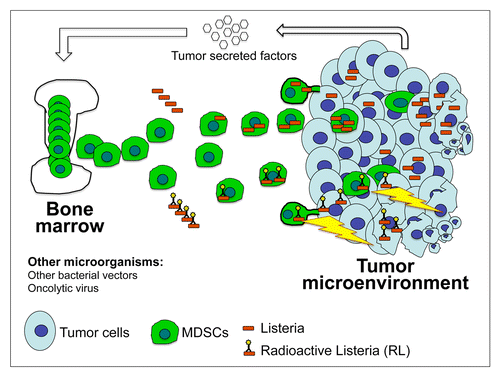Figures & data
Figure 1. Myeloid-derived suppressor cells for the delivery of microorganisms or anticancer agents to the tumor microenvironment. Large numbers of myeloid-derived suppressor cells (MDSCs) are released from the bone marrow into the bloodstream of tumor-bearing hosts. MDSCs are attracted to the tumor microenvironment (TME), including primary neoplastic lesions and metastases, by cytokines and other chemoattractants. Upon infection, MDSCs can selectively deliver microorganisms such as an attenuated variant Listeria monocytogenes (Listeria), as such or coupled to a radionuclide (RL), to the TME, where these microorganisms can spread to tumor cells. In thus far, MDSCs attack cancer cells like bomb-loaded missiles. Malignant cells will also be killed through a “crossfire effect,” i.e., the process whereby 188Rhenium (188Re) atoms taken up by one cell upon infection by RL also kill non-infected neighboring cells. With help of MDSCs, RT promotes the accumulation of radionuclides in primary tumors and metastases, promoting a significant inhibition of tumor growth as well as the near-to-complete elimination of metastases in a mouse model of pancreatic cancer. Also oncolytic viruses have been selectively delivered to the TME with the help of MDSCs, resulting in a reduction of tumor burden. Additional bacterial vectors are currently under investigation for the delivery of anticancer agents to the TME. Such novel immunotherapeutic regimens have great potential for the treatment of metastatic tumors.
